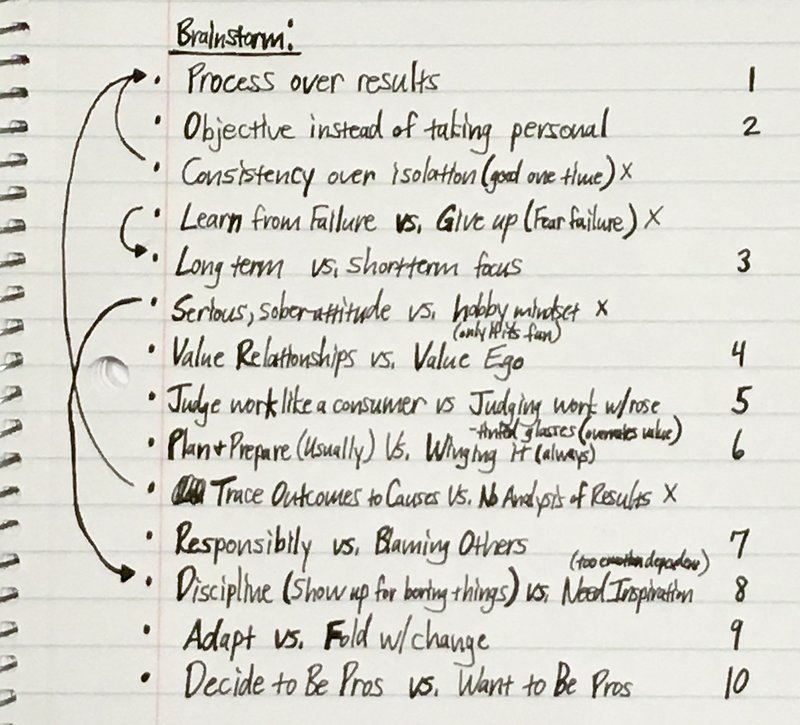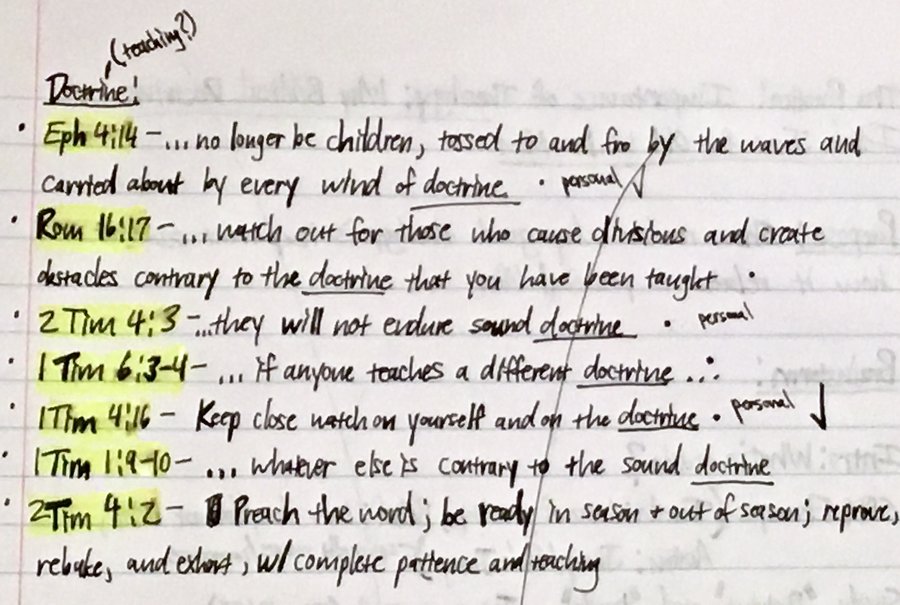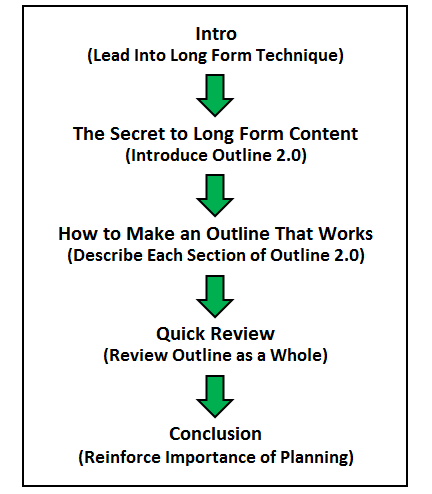 Long form content is all the rage these days.
Long form content is all the rage these days.
Forget the witty and insightful short posts of yesteryear. Readers today demand meaty articles that put encyclopedias to shame.
Good ol’ Google also loves this lengthy style. So if you want more traffic, long form content is the obvious choice.
But how do you actually make it? How do you consistently write engaging pieces that eclipse 2,000 words?
Well, it all starts with a secret. And this secret isn’t about writing at all.
The Secret to Long Form Content
Preparation.
It’s what separates the pros from the amateurs.
The experts do their thinking early so their instincts take over later. And if you want to write incredible long form content, you need to follow suit.
So how exactly do you do that?
It’s simple. You use my super-secret, confidential technique:
You make an outline.
Okay, I admit that’s far from classified material. Heck, they even teach outlines in grade school. But those aren’t the kind I’m talking about.
Good long form content requires more than your grandma’s outline. That’s why you need an outline 2.0.
You need more than a few writing points with bullets of information. So let’s take a look at everything else that’s involved.
How to Make an Outline That Works
 My best outlines always include the following elements:
My best outlines always include the following elements:
- Headline
- Purpose
- Brainstorm
- Research
- Structure
- Content
I use a spiral-bound notebook and devote at least four pages to cover these sections.
You can make a digital outline instead, but it’s quicker for me to do it by hand. Plus there’s something about the rawness of handwriting that I enjoy.
But anyway, each part of my outline helps me shape the finished article. So next, I’ll show you what to do at each step.
#1 Headline
First, you start with a headline.
The goal here is to write a title that says, “This post will solve your problem.”
You should already have a topic or keyword in mind when you start. So if need help writing a title, Google a related phrase and study what’s already there. This will keep you from copying a popular headline word-for-word and help you form a creative one.
Once you’ve seen some other headlines, you need to choose a format. Will you write a list post? A how-to? Or an in-depth guide?
Choose whatever you want, but make sure the format is in the title. That way readers will know what to expect.
Lastly, the headline should also grab your attention. You want a title that’s irresistible, something that’ll make readers late for work because they couldn’t avoid clicking.
How do you make a title like that you ask? You simply do the previous steps I mentioned, and then add a bold, impressive, or unexpected twist.
This means a good headline will include all the following:
- The problem your post will solve (or an interesting topic)
- The format of your article
- A creative twist
Doing this will turn boring headlines like these:
- The Value of Perseverance
- How to Read the Bible
- Life Advice I Wish I Knew Earlier
Into the following must-click titles:
- Uncanny Perseverance: 5 Common Threats to Greatness and How to Survive in Spite of Each
- How to Read the Bible: The Non-Overspiritualized Beginner’s Guide
- 202 Bits of Wisdom I Would Share With My Younger Self
Remember that this Headline section is extremely important—even though it is the shortest. If your title doesn’t make people care, they won’t click to read your content. And that would be a shame.
Why not give yourself a chance?
Revise your headline multiple times until it’s impossible to ignore.
Headline Key Points:
- The headline should include your topic, post type, and a creative twist.
- Review similar titles on the web and revise yours until it stands out.
- Ask yourself if you would click your own headline.
#2 Purpose
 Next, write your content’s purpose.
Next, write your content’s purpose.
Like the Headline section, this part may seem unimportant due its length, but a written purpose here will keep everything on track.
All you need is one sentence that concisely explains what your content will do. If I was writing this article’s purpose for example, I’d say something like this:
“Explain why a detailed outline is crucial for long form content, and show the reader how to make one.”
Everything in this post follows that purpose.
Again, this section seems insignificant, but it’s the driver behind your work.
I always review this statement when I outline and draft. I make sure every part relates to the purpose somehow, and if it doesn’t, it gets cut. Doing this helps me write with focus, which in turn keeps readers engaged even after 3,000 words.
Long form content is useless if people don’t stick around to finish. So if you want readers glued to the page, write a clear purpose, and align everything else.
Purpose Key Points:
- A purpose statement will focus your work on a specific task.
- Write one concise sentence that explains what the post will do.
- Review the purpose multiple times and keep other details aligned.
#3 Brainstorm
The Brainstorm section is where you gather initial thoughts on your topic.
Feel free to include any facts, sentences, or key points you want to share. No, all of them may not belong in your post, but it’s good practice to put all your ideas on paper.
After you’ve written your initial thoughts, stay at this section a few minutes and think about your topic. Then ask yourself what questions a reader might have.
What misconceptions do you want to address? What items will you include in your list? And which parts should you combine altogether?
Oftentimes, just writing these ideas will show you plenty of opportunities. And this will allow you to be thorough later on.

The great thing about brainstorming is that it doesn’t have to be perfect either. Your only job here is to put ideas on the page.
The time will come to choose what’s best, but at this point, write everything on your mind.
Brainstorm Key Points:
- Document initial thoughts on your topic.
- Include all facts, sentences, and ideas you want to share.
- Remember that “bad” ideas are fine too.
#4 Research (Optional)
The next part is Research.
I marked this section as optional because you won’t always need external help.
Your experience may already give you enough authority on the topic. Your content may also cover something unique to you, and if that’s the case, you can freestyle. But for most long form content, you’ll need knowledge from other sources.
Any info like the following belongs in this section:
- Quotes
- Interviews
- Article links
- Book references
- Podcast episodes
- YouTube videos
- And any other external material
Be sure to write why you included each piece too so you don’t forget. I usually write a summary of each entry, document its source, and then group similar thoughts.

Like the Brainstorm section, Research will also vary in length. It only takes half a page for some of my articles, but it consumes the whole outline on posts that go more in depth.
Don’t worry much about the length though. It’s better to have too much material here than to lack enough when you write.
Research Key Points:
- Include relevant info from external sources.
- Write a summary for each entry, document its source, and group it with similar findings.
- It’s better to get too much material than too little.
#5 Structure
Now it’s time to build your structure.
This section is the backbone of your post, a framework that will guide every paragraph, sentence, and word. So yeah, it’s pretty important.
The reason you need to be thorough at the Brainstorm and Research stages is so you can build a good structure here.
At this point, you decide which ideas from those stages are most relevant. Then, you make a flowchart showing how you’ll present your thoughts.
Think of this as a bird’s-eye-view of your post. It’s a map of the biggest ideas you’ll cover, and it should relate to your content’s purpose.
For example, here’s the purpose I wrote earlier:
“Explain why a detailed outline is crucial for long form content, and show the reader how to make one.”
Now here is my structure:

As you can see, this isn’t detailed at all. It’s just some ideas in a flowchart. But this chart helps me achieve my purpose from earlier. I have a section explaining why outlines are crucial for long form content, and I have another that shows how to make one.
Honestly, a reader could just look at my structure and decide if my post will be helpful. And that’s the goal here.
You want the map itself to tell a story. Then you‘ll expound your points later.
Structure Key Points:
- The post structure is a map of your future article.
- Use the best ideas from Brainstorm and Research to make a flowchart.
- The structure should tell a story of how your post will achieve its purpose.
#6 Content
Finally, you plan your content.
This section most resembles the outlines they showed you in school.
You’ll already have your biggest ideas mapped out here. So this is where you add meat to the bones.
You take your post structure, break it into subheadings, and then write bullet points for each. You should also note any pictures or stories you’d like to include and decide where to apply your research.
I write at least three points under each subheading so I know what to cover when I draft. Ordering these points also helps me plan the beginning, middle, and end of each part.

Besides these actions though, there’s not much to do here.
Again, you should already have most of your thinking done. Just flesh out your points more and your draft will basically write itself.
Content Key Points:
- Break your post structure into subheadings.
- List at least three bullet points with main ideas, research, and illustrations at each part.
- Organize key points to plan the flow of each section.
Quick Review
So there’s your outline.
If you write long form content, I recommend that you make something similar.
Following this technique will force you to organize thoughts beforehand. Then you’ll write a smooth and engaging article later.
But in case you forgot any of the previous steps, I’ve included a summary of each below:
- Headline: The title of your article. Revise the headline multiple times until it covers the topic, describes the format, and shows a creative twist.
- Purpose: One sentence that tells what your post is going to do. All your content should align with this statement.
- Brainstorm: A section for your initial thoughts. Don’t be afraid to include “bad” ideas here. You’ll decide which ones to use later.
- Research: Include all external info here. Write a summary for each entry, note the source locations, and sort the research by topic.
- Structure: Use the Brainstorm and Research sections to form a map of your post. This is a bird’s-eye-view of ideas that guides your long form content.
- Content: Make subheadings from your structure and write at least three bullet points under each. Assign all your research, flows, and illustrations too.
It All Starts With a Plan
 And there you have it.
And there you have it.
Good long form content doesn’t stem from your writing skills, pictures, or grand ideas (although those can help).
Good long form content results from the planning you do before.
So make your outline, sort your thoughts, and flesh ‘em out.
Your magnum opus will write itself if you do.
-Drew
Leave a Reply